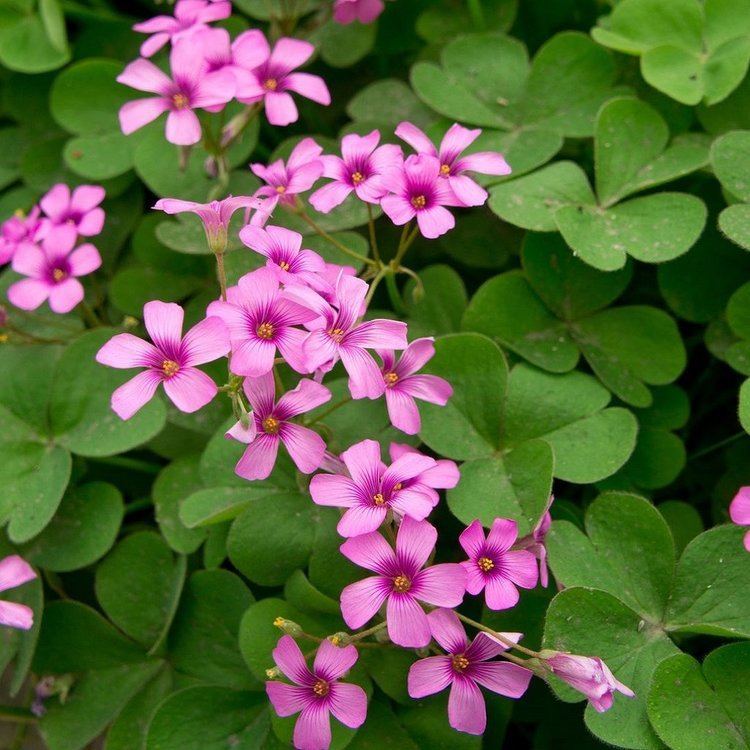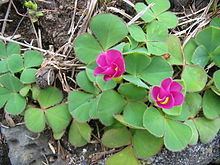Scientific name Oxalis Rank Genus | ||
Lower classifications Oxalis corniculata, Oxalis acetosella, Oxalis triangularis, Oxalis tetraphylla, Common Yellow Woodsorrel | ||
Oxalis growing tips
Oxalis /ˈɒksəlᵻs/ is by far the largest genus in the wood-sorrel family Oxalidaceae: of the approximately 900 known species in the Oxalidaceae, 800 belong here. The genus occurs throughout most of the world, except for the polar areas; species diversity is particularly rich in tropical Brazil, Mexico and South Africa.
Contents
- Oxalis growing tips
- How to divide your love plant oxalis triangularis
- Description and ecology
- As food
- For its oxalic acid content
- As ornamental plants
- Selected species
- References
Many of the species are known as wood sorrels (sometimes written "woodsorrels" or "wood-sorrels") as they have an acidic taste reminiscent of the unrelated sorrel proper (Rumex acetosa). Some species are called yellow sorrels or pink sorrels after the color of their flowers instead. Other species are colloquially known as false shamrocks, and some called sourgrasses. For the genus as a whole, the term oxalises is also used.

How to divide your love plant oxalis triangularis
Description and ecology

These plants are annual or perennial. The leaves are divided into three to ten or more obovate and top notched leaflets, arranged palmately with all the leaflets of roughly equal size. The majority of species have three leaflets; in these species, the leaves are superficially similar to those of some clovers. Some species exhibit rapid changes in leaf angle in response to temporarily high light intensity to decrease photoinhibition.
The flowers have five petals, which are usually fused at the base, and ten stamens. The petal color varies from white to pink, red or yellow; anthocyanins and xanthophylls may be present or absent but are generally not both present together in significant quantities, meaning that few wood-sorrels have bright orange flowers. The fruit is a small capsule containing several seeds. The roots are often tuberous and succulent, and several species also reproduce vegetatively by production of bulbils, which detach to produce new plants.
Several Oxalis species dominate the plant life in local woodland ecosystems, be it Coast Range ecoregion of the North American Pacific Northwest, or the Sydney Turpentine-Ironbark Forest in southeastern Australia where least yellow sorrel (O. exilis) is common. In the United Kingdom and neighboring Europe, common wood sorrel (O. acetosella) is the typical woodland member of this genus, forming large swaths in the typical mixed deciduous forests dominated by downy birch (Betula pubescens) and sessile oak (Quercus petraea), by sycamore maple (Acer pseudoplatanus), common bracken (Pteridium aquilinum), pedunculate oak (Q. robur) and blackberries (Rubus fruticosus agg.), or by common ash (Fraxinus excelsior), dog's mercury (Mercurialis perennis) and European rowan (Sorbus aucuparia); it is also common in woods of common juniper (Juniperus communis ssp. communis). Some species – notably Bermuda-buttercup (O. pes-caprae) and creeping woodsorrel (O. corniculata) – are pernicious, invasive weeds when escaping from cultivation outside their native ranges; the ability of most wood-sorrels to store reserve energy in their tubers makes them quite resistant to most weed control techniques.
Tuberous woodsorrels provide food for certain small herbivores – such as the Montezuma quail (Cyrtonyx montezumae). The foliage is eaten by some Lepidoptera, such as the Polyommatini pale grass blue (Pseudozizeeria maha) – which feeds on creeping wood sorrel and others – and dark grass blue (Zizeeria lysimon).
Oxalis species are susceptible to rust (Puccinia oxalidis).
As food
Wood sorrel (a type of oxalis) is an edible wild plant that has been consumed by humans around the world for millennia. In Dr. James Duke's Handbook of Edible Weeds, he notes that the Kiowa Indian tribe chewed wood sorrel to alleviate thirst on long trips, that the Potawatomi Indians cooked it with sugar to make a dessert, the Algonquin Indians considered it an aphrodisiac, the Cherokee ate wood sorrel to alleviate mouth sores and a sore throat, and the Iroquois ate wood sorrel to help with cramps, fever and nausea.
The fleshy, juicy edible tubers of the oca (O. tuberosa), have long been cultivated for food in Colombia and elsewhere in the northern Andes mountains of South America.
It is grown and sold in New Zealand as "New Zealand yam" (although not a true yam), and varieties are now available in yellow, orange, apricot, pink, as well as the traditional red-orange
The leaves of scurvy-grass sorrel (O. enneaphylla) were eaten by sailors travelling around Patagonia as a source of vitamin C to avoid scurvy.
In India, creeping wood sorrel (O. corniculata) is eaten only seasonally, starting December–January. The leaves of common wood sorrel (O. acetosella) may be used to make a lemony-tasting tea when dried.
For its oxalic acid content
A characteristic of members of this genus is that they contain oxalic acid (whose name references the genus), giving the leaves and flowers a sour taste which can make them refreshing to chew. In very large amounts, oxalic acid may be considered slightly toxic, interfering with proper digestion and kidney function. However, oxalic acid is also present in more commonly consumed foods such as spinach, broccoli, brussel sprouts, grapefruit, chives, and rhubarb, among many others. General scientific consensus seems to be that the risk of sheer toxicity, actual poisoning from oxalic acid, in persons with normal kidney function is "wildly unlikely".
While any oxalic acid-containing plant, such as Oxalis, is toxic to humans in some dosage, the U.S. National Institutes of Health note that oxalic acid is present in many foodstuffs found in the supermarket and its toxicity is generally of little or no consequence for people who eat a variety of foods.
In the past, it was a practice to extract crystals of calcium oxalate for use in treating diseases and as a salt called sal acetosella or "sorrel salt" (also known as "salt of lemon"). Growing oca tuber root caps are covered in a fluorescent slush rich in harmaline and harmine which apparently suppresses pests; this phenomenon has been studied to some extent at the Colorado State University. Creeping wood sorrel and perhaps other species are apparently hyperaccumulators of copper. The Ming Dynasty text Precious Secrets of the Realm of the King of Xin from 1421 describes how O. corniculata can be used to locate copper deposits as well as for geobotanical prospecting. It thus ought to have some potential for phytoremediation of contaminated soils.
As ornamental plants
Several species are grown as pot plants or as ornamental plants in gardens, for example, O. versicolor.
Oxalis flowers range in colour from whites to yellows, peaches, pinks, or multi-coloured flowers.
Some varieties have double flowers, for example the double form of O. compressus. Some varieties are grown for their foliage, such as the dark purple-leaved O. triangularis.
Species with four regular leaflets – in particular O. tetraphylla (four-leaved pink-sorrel) – are sometimes misleadingly sold as "four-leaf clover", taking advantage of the mystical status of four-leaf clover.
Selected species
Sources USDA, Nesom
